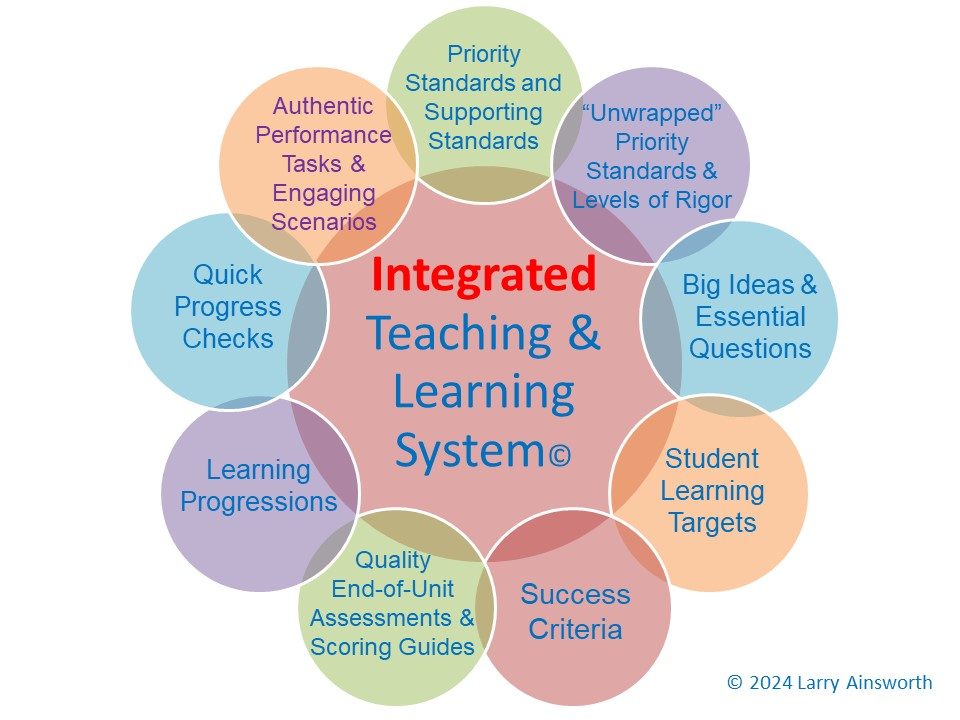Integrating Teaching and Learning: Creating Integrated Units of Study
WHAT: Student Learning Targets are simpler statements that communicate to students the complex learning expectations of the standards in age-appropriate language they can understand.
Student Learning Targets are “timeless essentials”, foundational to quality units of study. They specifically derived from the “unwrapped” Essential Standards assigned to each unit or set of related lessons. Think of each Student Learning Target as a simply reworded, essence statement without the explicit details and complex wording included in the standard.
Like the “unwrapped” Essential Standards, Student Learning Targets serve as the focal points of instruction, learning activities, and assessments. Their value lies in helping students make clear connections between what they are learning and how they can set a personal learning goal to achieve that learning.One aspect of creating integrated units of study that educators often find most valuable is after prioritizing and "unwrapping" standards (steps explained in the book link below), the next step is to make sure that students are clear about what their teachers want them to learn. Just as “unwrapping” provides educators with the clarity they need to fully understand the Essential Standards they are about to teach to their students, the way to communicate that same clarity to students is to “translate” those standards into age-appropriate student wording.
WHY:
“Without clarity of learning goals that provide the sharp focus for both instruction and assessment, teachers cannot achieve the maximum possible impact on student learning. Why do we share learning intentions (targets) with students? To identify what students will be learning; to explain the reason for the learning; to present them in language the students understand; and to revisit the learning intention throughout the lesson” (Cognition Education, 2014).
In an August 16, 2022, blog post based on her own professional experience, “Learning Targets That Motivate Students,” writer Laurie H. lists and describes “6 Advantages of Enhancing Student Learning Through Learning Targets” she observed in her students:
- 1. Increased Achievement
- 2. Added Motivation
- 3. Personal Responsibility
- 4. A Boost in Feedback
- 5. Improved Self-Reflection Abilities
- 6. Better Communication
HOW:
Creating clarity for students is easy once you know the steps to follow. First, educators “unwrap” the state standards they regard as essential for students to learn. Next, they write Student Learning Targets by focusing on the teachable concepts (important nouns and noun phrases) and the related skills (verbs) in each “unwrapped” Essential Standard assigned to that unit of study. They then identify the rigor of the standard (see link to book below) to be sure the rigor is represented in the Student Learning Target. Including academic vocabulary terms from the “unwrapped” standard in the Student Learning Target is a great way to introduce students to those new vocabulary terms they will be learning. Finally, simply restate the standard in student-friendly wording–being sure not to lose the rigor and intent of the actual standard.
For numerous educator-created and A.I.-generated examples of Student Learning Targets, including tools, tips, and step-by-step instructions, check out Integrating Teaching and Learning: "Timeless Essentials" for Creating Integrated Units of Study - Volume 1. Here are a few of the chapter sections:
- 1. Statement Starters for Student Learning Targets
- 2. Connecting Student Learning Targets with Daily Lessons
- 3. Involving Students in the Co-Creation of Student Learning Targets
- 4. How to Write Student Learning Targets for Multiple Essential Standards
- 5. A.I.-Generated Student Learning Targets (And How To Use Strategically!)
- 6. Practical Application Questions about Student Learning Targets
For examples of Learning Targets and more follow Larry on Facebook, Linked In, and Instagram!
As well be sure to contact us at larry@larryainsworth.com for more information on Larry's related workshop:

